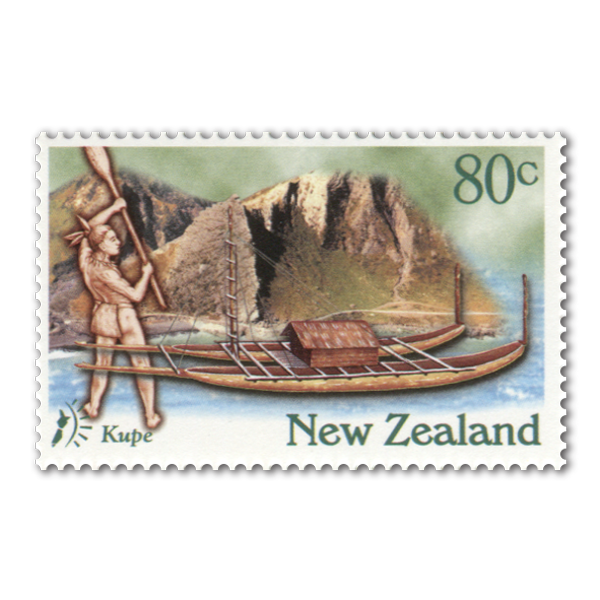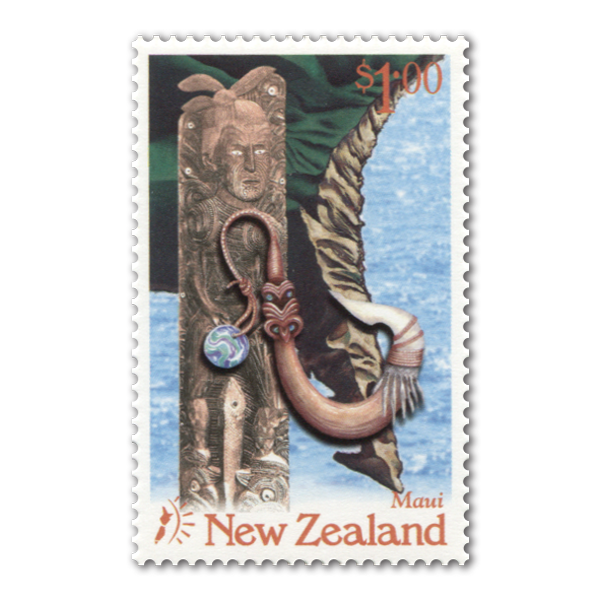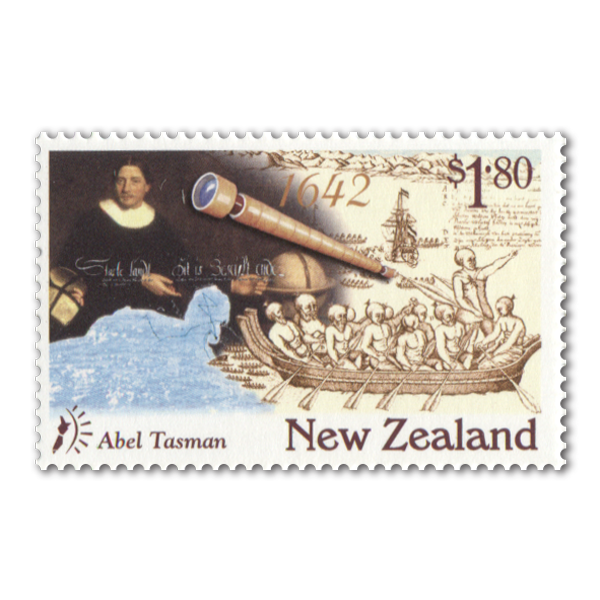The Discoverers - Millenium Part One stamp issue was the first in a series of six stamp issues, leading up to the year 2000.
Issue information
The Millennium Series will depict different aspects of New Zealand's development and history over the centuries. Discoverers - The Millennium Series Part One commemorated individuals who are linked with New Zealand's mythical origins and early recorded history.
Polynesians and Europeans searched for new lands for a variety of reasons - the pressures of growing populations, exhaustion of known resources, warfare, desire to enhance mana (prestige) and a thirst for knowledge.
According to Māori tradition, the first Polynesian explorer to reach Aotearoa was Kupe, who travelled across the Pacific in a Polynesian-style voyaging canoe. It is thought that Kupe reached what is now known as the Hokianga Harbour in Northland about 1,200 years ago.
European exploration of the Pacific began in 1520 when Ferdinand Magellan sailed around the southern tip of South America in the course of the first circumnavigation of the globe. Abel Tasman, James Cook and Jean de Surville, the first three European discoverers of New Zealand were looking for a 'great southern land', rumoured to contain great riches, which geographers thought must exist to balance the large continents of the Northern Hemisphere.
Product Listing for The Discoverers - Millenium Part One
| Image | Title | Description | Price |
|---|---|---|---|
 |
Single Stamp |
Single 40c 'James Cook' gummed stamp. In early October of 1769, English explorer James Cook sailed the Endeavour into Poverty Bay and went ashore. It was the first landing by a European in New Zealand and marked the beginning of a six month circumnavigation during which Cook produced an astonishingly accurate map of the coastline. The stamp shows an image of Cook with his famous map of New Zealand and the main navigational instrument of the time, the sextant. |
$0.40 |
 |
Single Stamp |
Single 80c 'Kupe' gummed stamp. The legendary voyager Kupe is a semi-divine figure who appears in the traditions of several Polynesian islands. According to some Māori accounts, he fled from Hawaiki with Kuru-maro-tini about the waka Matahorua. During this voyage he discovered New Zealand, which he named Aotearoa, which they explored extensively before returning to Hawaiki. Kupe is of most importance in the traditions and place names of the Cook Strait area (such as the landform near Cape Palliser known as Kupe's Sail). This landform is shown on the stamp, along with a 'rock-art' style drawing of Kupe and a double canoe of the type used for long sea voyages. |
$0.80 |
 |
Single Stamp |
Single $1.00 'Māui' gummed stamp. The mythical figure of Māui is found in many Polynesian cultures. Born prematurely and thrown into the sea by his mother Taranga, he was rescued and according to some traditions, was brought up by Rangi, the Sky God. Māui eventually returned to earth where, armed with supernatural powers, he led his older brothers in a series of exploits. Māori myth attributes the creation of New Zealand to Māui. While fishing with his brothers he pulled from the sea a gigantic fish which is now known as Te Ika a Māui (the fish of Māui) or the North Island. His canoe became the South Island. Māui's fish hook became the cape which now forms the southernmost tip of Hawkes Bay. A carved meeting house panel depicting Māui, his fish hook and Cape Kidnappers are shown on the stamp. |
$1.00 |
 |
Single Stamp |
Single $1.20 'Jean de Surville' gummed stamp. At the same time Cook was circumnavigating New Zealand in late 1769, the French ship St Jean Baptiste, under the leadership of Jean Francois Marie de Surville, anchored in Doubtless Bay in Northland. When a small boat disappeared, he took revenge by burning huts and other Māori possessions, and kidnapping the chief Raninui. After three anchors were lost in a storm, the St Jean Baptiste sailed away to the east. Ranginui died at sea, and de Surville drowned at Chilca, Peru in April 1770. The stamp featured images of de Surville's ship and the Pā site at Tokerau where the ship anchored. De Surville's anchor is also shown, indicative of the three anchors which were lost. |
$1.20 |
 |
Single Stamp |
Single $1.50 'Dumont d'Urville' gummed stamp. French explorer d'Urville made three voyages to New Zealand. During the second voyage, between 1826 and 1829, he charted the coast of both the North and South Islands extensively and made important botanical and entomological investigations. An illustration of a crab species discovered on one of his voyages is shown on the stamp. Also depicted is an engraving showing his passage through French Pass which separates D'Urville Island from the mainland in the Marlborough Sounds. |
$1.50 |
 |
Single Stamp |
Single $1.80 'Abel Tasman' gummed stamp. In 1642 Tasman was dispatched by the Dutch East India Company to discover the great continent which was believed to lie in the unknown southern ocean. What he did discover, on 13 December 1642, was New Zealand, which he named 'Staten Landt'. His attempt to land at what is now Golden Bay was thwarted when one of his boats was attacked by Māori war canoes. The original map of the western coastline he travelled up is shown on the stamp. Also featured is an illustration from Tasman's journal and a portrait believed to be of Tasman. |
$1.80 |
 |
First Day Cover | First day cover with stamps affixed. Cancelled on the first day of issue. | $7.20 |
 |
Presentation Pack | Presentation pack containing a selection of stamp products from the issue and further information on the theme of the stamps. | $8.50 |
Technical information
| Date of issue: | 12 February 1997 |
|---|---|
| Stamps and first day cover designed by: | Red Cactus Design, Wellington, New Zealand |
| Number of stamps: | Six |
| Denominations and designs: | 40c James Cook, 80c Kupe, $1.00 Māui, $1.20 Jean de Surville, $1.50 Dumont d'Urville, $1.80 Abel Tasman |
| Printer and process: | Southern Colour Print, Dunedin, New Zealand by lithography |
| Number of colours: | Four process colours plus one special |
| Stamp size and format: | 40mm x 28mm (horizontal), 28mm x 44mm (vertical) |
| Miniature sheet size: | 165mm x 90mm |
| Number of stamps per sheets: | 50 |
| Perforation gauge: | 14 |
| Paper type: | 103gsm gummed stamp paper |
| Cost of unaddressed first day cover: | $7.20 |
| Special blocks: | Plate/imprint, positional or value blocks could be obtained by purchasing at least six stamps. |
| Colour blocks: | Also known as 'traffic lights', these blocks were included in plate blocks. |
| Barcode blocks: | Barcode blocks were available in both A and B formats. |
| Period of sale: | These stamps remained on sale until 12 February 1998. |


